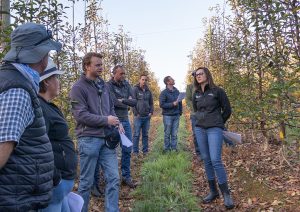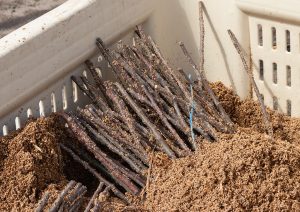
Geneva rootstocks in Brazil
Prof. Leo Rufato of the Universidade do Estado de Santa Catarina in Brazil shared his latest research results. By Anna Mouton.
“Ten years ago, we had only two rootstocks — the one was M.9, and the other was Marubakaido with an M.9 interstem,” said Rufato. “There were lots of problems with these rootstocks.”
M.9 tends to develop burr knots due to the formation of adventitious roots above ground. Burr knots predispose the tree to woolly apple aphid infestation. Both M.9 and Marubakaido produce abundant root suckers. They can also lead to excessive vigour which increases labour costs for pruning. Dense canopies reduce fruit quality and are difficult to harvest.
In response to these challenges, Rufato and his team started a project to evaluate Geneva rootstocks in more than twenty locations in the major apple-growing regions in southern Brazil. Trials were conducted with different cultivars in commercial orchards at different altitudes and with different soil types.
G.213 outperforms M.9
The first trial comparing Maxi Gala on G.213 and M.9 was planted in 2011. Trees were spaced 4 x 1 metre which translates into a tree density of 2 500 plants per hectare.
Rufato shared images of dormant seven-year-old trees that had been established on virgin soils. “You can see that the M.9 has a little difficulty with bud break at the top and that the branch angles are more closed. G.213 has more open branch angles and more branches at the top.”
The break-even point for these orchards is a cumulative yield of 150 tonnes per hectare. Trees on G.213 reached this target in 2017 — one year earlier than trees on M.9. The cumulative yield in 2020 was 42 tonnes per hectare more for G.213 than for M.9.
The cumulative production efficiency for G.213 for 2013–2020 was significantly higher than for M.9. Rufato highlighted the annual coefficient of variation showing that trees on G.213 alternated about 10% less than trees on M.9. G.213 is also more efficient and productive than M.9.
“The moment you plant in replant areas the difference is increased,” said Rufato. Bud break and branch angles in trees on M.9 are worse on replant soils.
On replant soils, trees on G.213 reached the break-even point of 150 tonnes per hectare in 2018 whereas those on M.9 took two years longer. The total cumulative yield in 2020 was 83 tonnes per hectare more for G.213 than for M.9.
Cumulative production efficiency was again greater and alternation less for G.213 than for M.9 — annual yield was 100% more stable for trees on G.213 than for trees on M.9.
Under the hood of G.213
Lack of uniform bud break due to insufficient winter chill is a problem in Brazil. Rufato presented data showing that bud break in the top of Maxi Gala trees grafted on G.213 was approximately 70% compared to 44% for Marubakaido with an M.9 interstem and 24% for M.9. The reason is that Maxi Gala on G.213 needs about 200 fewer chilling hours than Maxi Gala on M.9.
“But the question is why,” said Rufato. “Our theory is that it is because of the difference in hormone levels in the plants.”
Examination of the hormone levels from Maxi Gala sap showed that plants grafted on G.213 had lower levels of abscisic acid than plants grafted on Marubakaido. Abscisic acid is the primary hormone responsible for inducing and maintaining winter dormancy in buds. Lower abscisic acid levels at the end of winter are necessary for bud break.
Maxi Gala grafted on G.213 also had higher levels of jasmonic acid and trans-zeatin-riboside than plants grafted on M.9. Higher levels of jasmonic acid in G.213 are related to its increased disease resistance.
“Trans-zeatin-riboside is a cytokinin produced in the roots,” explained Rufato. “It is responsible for bud break and changes the branch angles of the plant.”
More Geneva rootstock trials
Rufato and his team started further trials in 2014. They compared G.202, G.213, G.757, and G.814 to M.9. The trees on M.9, G.213, and G.757 had similar vigour four years after planting on virgin soil. Trees on G.202 and G.814 were more vigorous than those on G.213.
All the trees on Geneva rootstocks reached the break-even cumulative yield of 150 tonnes per hectare in 2019 — M.9 trees took two years longer. The total cumulative yield for the G.213 trees in 2020 was 102 tonnes per hectare more than for the M.9 trees. G.213 was both more efficient and more productive than M.9.
M.9 performed less well on replant soils and the trees struggled to fill their space. Trees grafted on G.213 had more branches in the upper canopy and better branch angles. G.202 and G.814 also did well on replant soils.
Trees on G.202, G.213, and G.814 all reached the break-even yield of 150 tonnes per hectare in 2019 — G.757 narrowly missed the target. Trees on M.9 reached break-even in 2020. The total cumulative yield for the trees on G.213 was 82 tonnes per hectare more than for the trees on M.9.
According to Rufato, two-dimensional high-density plantings are the future for apple orchards in Brazil. “But what is the best rootstock?” he asked. Trials of Maxi Gala and Fuji Suprema planted on G.213 and M.9 in 2015 aim to answer this question.
“Over four production years we observed that Maxi Gala produced 145 tonnes per hectare more on G.213 than on M.9,” reported Rufato. “In Fuji, the difference is 60 tonnes per hectare.”
Rufato has found that G.41, G.213, and G.757 have similar vigour to M.9 under Brazilian conditions, but G.41 is sensitive to low pH. G.11 and G.696 do not perform well in Brazil. G.202 is good for colder areas but not suited to warm conditions.
Of the more vigorous rootstocks, G.222 also works well in Brazil, and G.210 is a good option for Fuji. Although an excellent rootstock, G.935 is susceptible to nematodes.
Geneva rootstocks are micropropagated in Brazil. Figures show that production of G.213 outstripped that of other Geneva rootstocks in 2020 and 2021. If G.213 lives up to the promise it has so far shown, Brazilian growers can soon look forward to increased productivity and profitability.
Image: Prof. Leo Rufato, Universidade do Estado de Santa Catarina, Brazil. Supplied by Prof. Leo Rufato.






